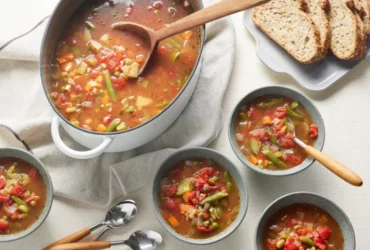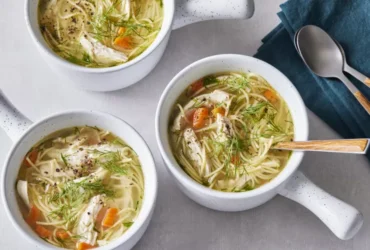4 Chef-Approved Ways to Make Soup Less Salty and Tips to Avoid Oversalting
Making soup is a comforting and rewarding experience. However, we’ve all been there—oversalting our soup and realizing too late that our culinary creation has turned into a salty disaster.
Don’t worry; this is a common kitchen mishap, even for professional chefs. Luckily, we have some effective strategies to rescue your soup and keep it delicious.
Here are four chef-approved ways to make soup less salty and some handy tips to prevent oversalting in the first place.

Understanding Salt in Soup
Salt enhances flavor and acts as a preservative in cooking. However, finding the right balance is essential to avoid overpowering your dish. If you’ve added too much salt, don’t despair!
Let’s explore how to rescue your salty soup and keep your future soups perfectly seasoned.
1. Increase the Volume of Your Soup
One of the simplest methods to counteract oversalting is to increase the volume of your soup.
Chef Matt Krimsky, a culinary expert at Genuine Foods, recommends this technique as the most effective solution. By simply making more soup, you dilute the salt concentration.
- How to Do It: If your soup is too salty, consider doubling your batch. For example, if you made a tomato soup, prepare another batch of unsalted soup and combine it. This approach not only balances the saltiness but also allows you to enjoy more of your favorite soup.
2. Dilute Your Soup with Unsalted Ingredients
Another chef-approved way to make soup less salty is to dilute it with unsalted broth or liquids. This method helps to reduce the overall saltiness while retaining the soup’s original flavor.
- Unsalted Broth: Add unsalted chicken or vegetable broth to your soup and let it simmer. This will help restore the soup’s consistency and flavor without the extra salt.
- Thickening Agents: Mix unsalted broth with a thickener like flour or cornstarch. Create a slurry by blending the thickener with a bit of water before adding it to the soup. This method absorbs some salt while achieving the desired thickness.
- Cream or Milk: For creamy soups, consider adding cream, milk, or non-dairy alternatives. Stir in small amounts and taste as you go to ensure you don’t alter the flavor too much.
3. Add Raw Potato
If you can’t increase the volume or dilute your soup, adding a raw potato can help extract some of the salt.
- How to Do It: Peel and add a whole potato to the simmering soup. Let it cook for about 20 minutes. The potato absorbs excess salt during cooking. Once cooked, remove the potato before serving. You can mash it and blend it back into the soup for an extra creamy texture, as long as it isn’t too salty.
4. Incorporate Acid
Adding acidic ingredients is another effective method to cut down on saltiness. Acid can help brighten flavors and mask the salty taste.
- Citrus: A squeeze of fresh lemon juice can work wonders in savory soups like lentils or mushroom soup. This adds brightness and balances the flavors.
- Vinegar: If you’re making a tomato soup, a splash of red wine vinegar can enhance the flavor while reducing the perception of saltiness. For meat-based soups, consider using complementary vinegars like apple cider or balsamic.
- Garnishes: Acidic garnishes, such as lemon zest, lime wedges, or yogurt, can also mitigate saltiness and elevate the dish. Fresh herbs, such as parsley or cilantro, add freshness and complexity, making them perfect companions for salty soups.

Tips to Prevent Oversalting Soup
Preventing oversalting in the first place is easier than fixing it afterward. Here are some useful tips to ensure your soup stays well-balanced.
Season in Layers
Instead of adding all the salt at once, season your soup in layers. Taste as you go, adjusting the salt incrementally to find the right balance.
Use Low-Sodium Ingredients
Opt for unsalted or low-sodium broths when preparing your soup. This allows you to control the amount of salt added, ensuring a more pleasant flavor.
Monitor Ingredients with Salt
Be mindful of any ingredients that may contribute additional salt to your soup. Items like canned beans, tomatoes, or frozen vegetables often contain sodium.
Always read labels and adjust your salt levels accordingly.
Control Boiling and Reduction
Be cautious with boiling and reducing your soup. While reduction can enhance flavors, it also concentrates salt.
Maintain a gentle simmer rather than an aggressive boil to avoid intensifying the saltiness.
Start with Roasted Vegetables
Begin with roasted vegetables instead of raw ones. Roasting brings out natural sugars and flavors, reducing the need for extra salt.
Use Fresh Herbs
Incorporate fresh herbs to build flavor without relying on salt. Herbs add depth and aroma, enhancing your soup without increasing sodium levels.

Conclusion
With these four chef-approved ways to make soup less salty and tips to prevent oversalting, you can confidently navigate your soup-making journey.
Whether you need to dilute your soup, increase its volume, or add acidity, you have the tools to create a flavorful dish every time.
Remember, a well-balanced soup is just a few adjustments away.
FAQs
What can I do if my soup is too salty?
You can dilute it by adding more broth or ingredients, use raw potato, or add acidic components like lemon juice or vinegar.
How can I prevent oversalting my soup?
Season in layers, use unsalted ingredients, and monitor any salty components you add.
Can I fix salty soup with sugar?
While sugar can balance flavors, it’s not the best fix. Try the methods mentioned for more effective results.
What types of acid work best in soup?
Citrus juices like lemon and vinegar are excellent choices to cut through saltiness.
Is it safe to eat soup made with too much salt?
While it’s not harmful, overly salty soup can be unpleasant. Adjust the flavors using the methods discussed.
References
- Food Network: How to Fix Overly Salty Soup
- Culinary Institute of America: Cooking Techniques
- Serious Eats: Soup Basics
- Epicurious: Tips for Cooking Soup















Leave a Reply